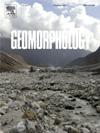Predicting urban channel morphology amidst multiple complexities
IF 3.1
2区 地球科学
Q2 GEOGRAPHY, PHYSICAL
引用次数: 0
Abstract
Urbanisation has resulted in rapid geomorphic changes and ecosystem degradation in many streams worldwide. The question of how channel response to urbanisation can be accurately predicted amid multiple driving factors remains a significant scientific challenge. Numerous efforts have been made to address this issue over the past 80 years. Nevertheless, channel response resulting from urbanisation differs across physiographic regions, making it difficult to predict. The main goal of this study is to investigate the most important factors influencing morphological changes, such as channel area, in streams with urbanised catchments. To accomplish this aim, we reviewed the literature on the application of hydraulic geometry models to urban-impacted rivers worldwide. We set out to investigate two specific questions: (i) to what extent and under what circumstances can urban stream bankfull cross-sectional area be predicted by catchment area and impervious cover metrics? and (ii) is stream bankfull width more susceptible than stream bankfull depth to urban-induced enlargement? However, over 90 % of the urban channels studied in the literature we reviewed showed irregular response patterns to urbanisation, owing to the complex interplay of local factors, such as geology, sediment, hardpoints, and riparian vegetation. Our most important conclusion is that local context is an important controller of stream channel response to urbanisation. While catchment area is a good predictor of channel area in some urban sites, it is a poor predictor of channel area in other urban sites. This contrasts with non-urban sites, where catchment area usually predicts channel area more strongly. In addition, impervious cover alone, which represents the direct hydrological impact of urbanisation, is insufficient to fully explain channel enlargement and incision. Therefore, models of channel response to urbanisation must consider the specific local factors that drive or limit these responses in order to be effective as predictive and explanatory tools.
在多重复杂性中预测城市河道形态
城市化导致全球许多河流的地貌迅速变化和生态系统退化。在多种驱动因素的作用下,如何准确预测河道对城市化的反应仍然是一个重大的科学挑战。在过去的 80 年中,人们为解决这一问题做出了大量努力。然而,城市化导致的河道响应在不同的地理区域存在差异,因此难以预测。本研究的主要目标是调查影响城市化集水区河道面积等形态变化的最重要因素。为了实现这一目标,我们查阅了有关将水力几何学模型应用于全球受城市影响河流的文献。我们着手研究两个具体问题:(i) 在何种程度上和何种情况下,城市河流的河岸横截面积可以通过集水面积和不透水覆盖率指标进行预测? (ii) 与河岸深度相比,河岸宽度是否更容易受到城市引起的河道扩大的影响?然而,由于地质、沉积物、硬点和河岸植被等当地因素的复杂相互作用,在我们查阅的文献中,超过 90% 的城市河道对城市化的反应模式不规则。我们最重要的结论是,当地环境是河道对城市化反应的重要控制因素。在某些城市地区,集水区可以很好地预测河道面积,但在其他城市地区,集水区却不能很好地预测河道面积。这与非城市地区形成了鲜明对比,在非城市地区,集水面积通常能更准确地预测河道面积。此外,仅仅是不透水覆盖(代表城市化的直接水文影响)还不足以完全解释河道的扩大和内切。因此,河道对城市化反应的模型必须考虑驱动或限制这些反应的当地特定因素,才能有效地作为预测和解释工具。
本文章由计算机程序翻译,如有差异,请以英文原文为准。
求助全文
约1分钟内获得全文
求助全文
来源期刊

Geomorphology
地学-地球科学综合
CiteScore
8.00
自引率
10.30%
发文量
309
审稿时长
3.4 months
期刊介绍:
Our journal''s scope includes geomorphic themes of: tectonics and regional structure; glacial processes and landforms; fluvial sequences, Quaternary environmental change and dating; fluvial processes and landforms; mass movement, slopes and periglacial processes; hillslopes and soil erosion; weathering, karst and soils; aeolian processes and landforms, coastal dunes and arid environments; coastal and marine processes, estuaries and lakes; modelling, theoretical and quantitative geomorphology; DEM, GIS and remote sensing methods and applications; hazards, applied and planetary geomorphology; and volcanics.
 求助内容:
求助内容: 应助结果提醒方式:
应助结果提醒方式:


